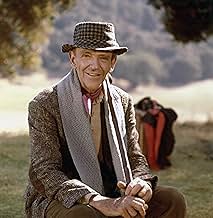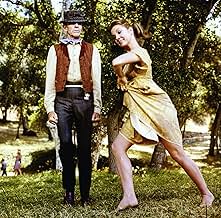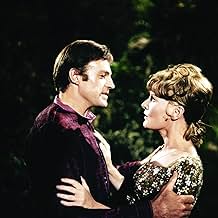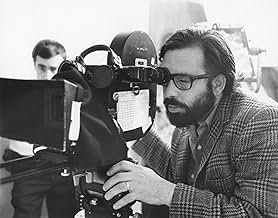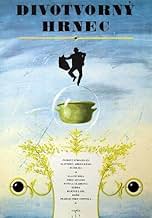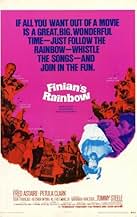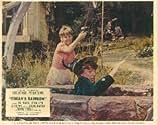CALIFICACIÓN DE IMDb
6.1/10
4.5 k
TU CALIFICACIÓN
Un inmigrante irlandés y su hija se trasladan al sur de Estados Unidos con una mágica pieza de oro que cambiará la vida de la gente, incluidos un granjero en apuros y ciudadanos afroamerican... Leer todoUn inmigrante irlandés y su hija se trasladan al sur de Estados Unidos con una mágica pieza de oro que cambiará la vida de la gente, incluidos un granjero en apuros y ciudadanos afroamericanos amenazados por un político intolerante.Un inmigrante irlandés y su hija se trasladan al sur de Estados Unidos con una mágica pieza de oro que cambiará la vida de la gente, incluidos un granjero en apuros y ciudadanos afroamericanos amenazados por un político intolerante.
- Dirección
- Guionistas
- Elenco
- Nominado a 2 premios Óscar
- 1 premio ganado y 9 nominaciones en total
Brenda Arnau
- Sharecropper 'Necessity'
- (sin créditos)
Charles Carter
- Sharecropper
- (sin créditos)
Sterling Clark
- Sharecropper
- (sin créditos)
Robert Cleaves
- Geologist
- (sin créditos)
Robert Cole
- Sharecropper
- (sin créditos)
Willie Covan
- Sharecropper
- (sin créditos)
Evelyn Dutton
- Sharecropper
- (sin créditos)
Opiniones destacadas
I first saw this movie as a young girl and developed an instant crush on Tommy Steele. The storyline is very entertaining with a keen sense of humor. It was also great seeing Fred Astaire again - I'm a big fan. This movie has some of the most memorable songs which are still among my favorites, of course many of them featuring Petula Clarke. If you are a fan of musicals and enjoy a bit of the blarney - then this movie will be right up your ally.
"Finian's Rainbow" (1968) is one of the few films I saw three times in the theater, and since repeat viewings are normally not my thing it must have made some connection or maybe I just enjoyed watching Barbara Hancock dance. Despite this I agree with most of the critical comments about portions of the film.
Unfortunately it was assembled as a 145 minute "roadshow" musical; these were overlong spectaculars which depended less on the charm of the performers (think 1930's) than on pre-sold event marketing (unnecessary, pretentious, overscale, and distracting production values; souvenir programs; etc.). Right around the time of its release these mega-productions were leading many of the studios to financial ruin. Warner Brothers took a hit from this one; box office was bad but fortunately Coppola worked cheap and had cranked this out on the back-lot with a relatively modest budget.
Trim about 30 minutes from the film and you would have a much better production. There is a lot of stuff here that is supposed to be fun and just doesn't make it. Fortunately there are some real gems sandwiched throughout the film.
Think bi-racial "Lil Abner" (1959) with a touch of "The Wizard of Oz" (1939). The Oz connection comes from lyricist E. Y. Harburg, the guy who gave us "If I Were the King of the Forest". There are enough such silly songs to make up for toughing out the musical clunker moments. Tommy Steele absolutely shines doing this material (insert Bert Lahr here) .
Nothing wrong with the performances of Fred Astaire or Petula Clark either. And its not just his dancing and her singing, they both achieve excellent characterizations. Astaire at 70 does not look much different facially than Astaire at 30. But this time instead of a physically unlikely love interest he plays a warm old man still chasing a dream, and it's a much better fit. Clark does an excellent Debbie Reynolds and more than holds her own through the production.
Unfortunately there is little good to say about the casting of Don Francks as Petula's love interest and Hancock's older brother. Most likely Coppola felt that the film needed a relatively hip looking guy in place of a Gordon MacRae type. But Francks comes off as more of an oily hotshot; the kind of guy who would proposition your 14 year-old sister.
The plot has Finian and his daughter coming to Kentucky to bury a crock of gold he has stolen from a leprechaun back in Ireland. Finian believes that he can produce some kind of synergy by getting the gold within close range of Ft. Knox. They end up in a racially mixed Dogpatch named Rainbow Valley, where blacks and whites work side-by-side as tobacco sharecroppers. There is considerable intrigue involving the local racist political hacks, a new strain of mentholated tobacco being developed by a George Washington Carver type (nicely played by Al Freeman Jr.), back taxes on the sharecropping collective, romance, and a leprechaun who is slowly becoming human.
Barbara Hancock, a young but quite accomplished ballet dancer, is fetching as "Susan the Silent" (who dances instead of talking). Coppola adds a lot of nice lyrical moments by showcasing her dancing. It is said that Astaire resented her being cast instead of an older dancer he recommended. They are not paired in any number, a failure conspicuous by its absence.
The widescreen DVD looks great and the Coppola commentary is surprisingly interesting.
Then again, what do I know? I'm only a child.
Unfortunately it was assembled as a 145 minute "roadshow" musical; these were overlong spectaculars which depended less on the charm of the performers (think 1930's) than on pre-sold event marketing (unnecessary, pretentious, overscale, and distracting production values; souvenir programs; etc.). Right around the time of its release these mega-productions were leading many of the studios to financial ruin. Warner Brothers took a hit from this one; box office was bad but fortunately Coppola worked cheap and had cranked this out on the back-lot with a relatively modest budget.
Trim about 30 minutes from the film and you would have a much better production. There is a lot of stuff here that is supposed to be fun and just doesn't make it. Fortunately there are some real gems sandwiched throughout the film.
Think bi-racial "Lil Abner" (1959) with a touch of "The Wizard of Oz" (1939). The Oz connection comes from lyricist E. Y. Harburg, the guy who gave us "If I Were the King of the Forest". There are enough such silly songs to make up for toughing out the musical clunker moments. Tommy Steele absolutely shines doing this material (insert Bert Lahr here) .
Nothing wrong with the performances of Fred Astaire or Petula Clark either. And its not just his dancing and her singing, they both achieve excellent characterizations. Astaire at 70 does not look much different facially than Astaire at 30. But this time instead of a physically unlikely love interest he plays a warm old man still chasing a dream, and it's a much better fit. Clark does an excellent Debbie Reynolds and more than holds her own through the production.
Unfortunately there is little good to say about the casting of Don Francks as Petula's love interest and Hancock's older brother. Most likely Coppola felt that the film needed a relatively hip looking guy in place of a Gordon MacRae type. But Francks comes off as more of an oily hotshot; the kind of guy who would proposition your 14 year-old sister.
The plot has Finian and his daughter coming to Kentucky to bury a crock of gold he has stolen from a leprechaun back in Ireland. Finian believes that he can produce some kind of synergy by getting the gold within close range of Ft. Knox. They end up in a racially mixed Dogpatch named Rainbow Valley, where blacks and whites work side-by-side as tobacco sharecroppers. There is considerable intrigue involving the local racist political hacks, a new strain of mentholated tobacco being developed by a George Washington Carver type (nicely played by Al Freeman Jr.), back taxes on the sharecropping collective, romance, and a leprechaun who is slowly becoming human.
Barbara Hancock, a young but quite accomplished ballet dancer, is fetching as "Susan the Silent" (who dances instead of talking). Coppola adds a lot of nice lyrical moments by showcasing her dancing. It is said that Astaire resented her being cast instead of an older dancer he recommended. They are not paired in any number, a failure conspicuous by its absence.
The widescreen DVD looks great and the Coppola commentary is surprisingly interesting.
Then again, what do I know? I'm only a child.
I remember seeing this film when it was first released. I absolutely hated it - too slow-moving, and the male romantic lead was a cipher. Even the songs were manipulated to the point that I could barely stand to listen to them. Tommy Steele was far too frenetic as Og, the leprechaun. Its saving graces were Fred Astaire, Petula Clark (although she seemed too old in the role of Sharon), and Keenan Wynn. I've avoided it like the plague ever since.
Tonight, thanks to Turner Classic Movies, I finally watched it again. And you know what? It's a lot better than I remembered. I don't know what has caused the turnabout in my opinion, except perhaps the lack of quality of most of the musical films that have come along since FINIAN'S RAINBOW in 1968. It still has a few longueurs, but generally it's very enjoyable. Even Tommy Steele isn't too bad. Don Francks is still dramatically stiff, but he's better than I remembered, and he sings well. And oh, those songs! It's a shame that "Necessity" was cut, but otherwise, what a string of melody - How are Things in Glocca Morra, Old Devil Moon, When I'm not Near the Girl I Love, and more.
Thank you, TCM, for giving me a second chance with this film!
Tonight, thanks to Turner Classic Movies, I finally watched it again. And you know what? It's a lot better than I remembered. I don't know what has caused the turnabout in my opinion, except perhaps the lack of quality of most of the musical films that have come along since FINIAN'S RAINBOW in 1968. It still has a few longueurs, but generally it's very enjoyable. Even Tommy Steele isn't too bad. Don Francks is still dramatically stiff, but he's better than I remembered, and he sings well. And oh, those songs! It's a shame that "Necessity" was cut, but otherwise, what a string of melody - How are Things in Glocca Morra, Old Devil Moon, When I'm not Near the Girl I Love, and more.
Thank you, TCM, for giving me a second chance with this film!
Whimsical is not a word I get to use often, but that's exactly what Finian's Rainbow is. Based on the 1947 stage musical it's part fantasy and part political satire. The plot follows the quintessential Irishman Finian(Fred Astaire in his last full screen role) and his daughter Sharon (Petula Clark) as they basically flee to America with a pot of gold stolen from the leprechaun, Og (Tommy Steele). After an amazing opening credit sequence ("Look To The Rainbow"), they arrive in "Misitucky" which is supposed to be near Fort Knox, to bury the gold in the belief that it will multiply. The small hamlet of Rainbow Valley becomes their home, a kind of Tobacco Road with very poor but very happy hippie-like inhabitants. Here Sharon meets her love interest Woody (Don Francks) Add Keenan Wynn as the villain, Senator Hawkins, a racist Southern stereotype that during the course of the story turns black. Several minor plots weave in and out, creating a rich and unique film. Astaire used to sound stages and carefully planned dance numbers balked at dancing outside in a field and the director, Francis Ford Coppola (an odd choice, but what's done is done) tried his best to meet his demands. Ironically the field sequence, which comes early in the film is beautiful and very well done by the choreographer Hermes Pan, who was subsequently fired from the film. Petula Clark clearly steals the movie. The camera loves her in this and her natural beauty and performance are such a pleasure to watch. Astaire, who was criticized cruelly for his appearance (he was 69 at the time) is as usual charming and no one danced like he did. Francks holds his own and makes a nice compliment to Clark. Tommy Steele's performance rolics between delightful and way too over the top. Beautifully filmed, it does suffer from jarring "this is real, this is fake" scenery but if you just go with it, it's not that bad. The DVD presents Astaire's dance numbers complete and full body (something Astaire always insisted on but was overlooked in the original release) Finian's Rainbow is known now more for many of it's songs than itself as a whole, but it's still very much worth a look, especially if you love musicals.
This was Fred Astaire's last full-blown musical movie ("That's Entertainment II" is not counted). The original play, written back in the 1930's, dealt more with the organization of a union by a bunch of poor sharecroppers. But by the time this movie was finally set to be made, unions were no longer the "hot topic", thus the racism angle was embellished. Plot aside, which isn't difficult, the basis of the story is that Finian McGlonnagen (Fred Astaire) has stolen a pot of gold from Og the leprechaun (played to perfection by Tommy Steele) and has plans to bury it near Fort Knox, thinking that the "magical properties" in the ground there will make more gold for him. Not exactly Pulitzer stuff here, but an enjoyable movie. A great vehicle for Keenan Wynn, showing why he was the best character actor of his day, and Tommy Steele, who disappeared from American movie screens far too soon. Great music; Good movie.
¿Sabías que…?
- TriviaMany, including Fred Astaire, blamed director Francis Ford Coppola for cutting off Astaire's feet during filming of his dancing scenes, but it was Warner Bros. who decided, after the filming had been completed in 35mm, to convert the film to the wider 70mm and promote it as a "reserved-ticket roadshow attraction." This was achieved by cropping off the tops and bottoms of the film frame, including some shots of Astaire's footwork.
- ErroresIn the song "Old Devil Moon" as Woody and Sharon dance through the stream, Woody has bare feet and his hands are in Sharon's. In the next shot, he has his shoes on, and it even looks as if his trousers are dry.
- Versiones alternativasFilmed in 35mm, Warners decided afterwards to promote it as a "reserved-ticket roadshow attraction" and converted it to 70mm, creating a wider-screen aspect ratio by cropping away the tops and bottoms of the images, and cropping away Fred Astaire's feet during some of his dance scenes. Restored versions show the original aspect ratio.
- ConexionesEdited into The Kid Stays in the Picture (2002)
- Bandas sonorasLook To The Rainbow / How Are Things In Glocca Morra?
(1946) (uncredited)
(Main Title)
Played during the opening credits
Lyrics by E.Y. Harburg
Music by Burton Lane
Sung by Petula Clark ("Rainbow") and played by the Warner Bros.
Orchestra ("Glocca Morra") conducted by Ray Heindorf
Selecciones populares
Inicia sesión para calificar y agrega a la lista de videos para obtener recomendaciones personalizadas
- How long is Finian's Rainbow?Con tecnología de Alexa
Detalles
Taquilla
- Presupuesto
- USD 3,500,000 (estimado)
- Tiempo de ejecución2 horas 21 minutos
- Relación de aspecto
- 2.39 : 1
Contribuir a esta página
Sugiere una edición o agrega el contenido que falta


